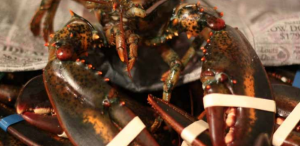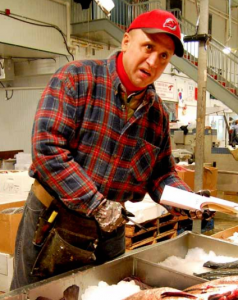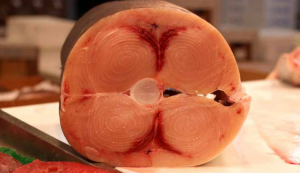Restoring New York’s Bond to the Sea.
It is three in the morning. You are in the Bronx, and it hits you: the smell of the sea, diesel and, above all, fish. You enter the warehouse and brine, salt and sweat fills the air. Next come the sound of the men: shouting expletives, spitting and laughing. Squeaks of boots, the shriek of metal on metal as knives are sharpened. Forklifts speed over a wet floor, pallets drop, ice spills and raw meat is deftly sliced. And finally, surrounding you, flying through the air, onto cutting boards and scales, are the fish. Countless varieties of seafood, changing hands from the fishmongers to the cooks, the restaurateurs, the Chinatown shopkeepers and the gourmands who come five days a week to the New Fulton Fish Market.

It is the second largest fish market in the world, handling millions of pounds of seafood daily and boasting annual sales of over $1 billion. The market moved to Hunts Point in the Bronx, eight years ago, from South Street in Lower Manhattan. During its 183-year tenure, the Fulton Street Market grew into the largest and most profitable fish market on the Eastern seaboard of the United States. Fishermen would haul in their catch daily, straight from the boat, until the 1950s, when transportation by trucks became common practice. In 2005, the Market moved to its current larger, climate-controlled facility. The move swiftly and effectively ended Manhattan’s fishing industry.
*****
In the years that have followed, New Yorkers have grown fearful of local seafood, either having been scared away by mercury warnings or, sticker shock in Whole Foods and upscale restaurants. This lack of information frustrated two New York restaurant veterans, Dennis O’Connor and Samantha Lee, who, with their friend Sean Dixon, an environmental lawyer, decided to found the third Community Supported Fishery (CSF) in New York. The three based their business on a three-prong model of local sources, responsible harvesting and transparency, and in 2012 they launched Village Fishmonger.
The role of the fish market has changed over time. Once people could walk out of their homes and buy fish either straight from the fisherman or from the fishmonger who worked with him. As Fulton Fish Market grew in size and began to mainly accommodate large-scale purchases from chefs and grocers, the gap began to widen. Their move to the Bronx was the cut-off. But now CSFs are moving to fill that gap.

“We started out in an apartment in the East Village, thinking about how we could get the best quality, most local, most responsibly-harvested seafood from the fisheries in New York and New Jersey to the people in New York City,” said Dixon. “What a lot of people don’t know about New York is that New York and New Jersey land tons and tons of fish. A huge portion of which comes directly to the city anyway, but isn’t sold as fresh or Long Island seafood, so it doesn’t really get into the consumer’s kitchens as readily as we like to see. We decided to short-circuit that whole supply chain issue and bring that amazing seafood direct to the consumers.”
Village Fishmonger has a team of about five part-time employees and two or three fishmongers. In the morning, fishermen will land with their catch of the day and drivers will pick it up and bring it to the Pfizer Building in Brooklyn, where the CSF rents a space alongside several other small restaurant operations. There, the fishmongers will prep, scale, filet and package the fish, take it to the pick-up locations and hand it out in time for customers to eat it for their evening meal. “This is really the freshest seafood you’re going to get unless you’re catching it yourself,” said Lee. Members of the CSF sign up for weekly or bi-weekly shares of fish, which are priced accordingly. Prices are higher than a wholesaler, but lower than a retail vendor.
Village Fishmonger’s main goal is “demystifying the seafood-buying process and bringing responsibly-harvested seafood to New York residents,” said Lee. “Most people, they’re just trying to make dinner.”
Dixon, Lee and O’Connor aim to give their members as little or as much information as they want. Dixon had long ago acknowledged the discrepancies in the national seafood guide reports, which do not take into account local populations such as those in New York Harbor. Village Fishmonger aims to alleviate some of the confusion, acting as the “crossing guards” for the consumer.
“Our model says we source responsibly,” said O’Connor. “We get it fresh; We don’t tell the fishermen what to give us.” There is no dictated price or set pick of the day. The idea is to give the fishermen “the freedom and the ability to source responsibly and whatever their nets should be catching, they’re catching,” said O’Connor.

“People are beginning to understand that knowing where your food comes from and who grew or caught it makes a difference,” said Matt Grove of Big City Fish Share, a CSF which operates out of New Amsterdam Market, near the historic Fulton Fish Market. “Eating is such a huge part of culture and what it means to be a human.”
This relationship to local fishermen is a large part of what makes a CSF successful, just like it benefitted the historic Fulton Fish Market. It is shortening the line from who catches the fish to who eats it. “Fishermen like to know who’s consuming their product and right now, their product goes out into the ether of the food supply chain,” said Lee. “But that connection is still important to them.”
*****
On the far reaches of Long Island, Mike Doall and Mike Martinsen founded Montauk Shellfish Company — which works with Mermaid’s Garden — the first CSF based in Brooklyn. “We knew that this was such a great idea and that this was the way to go and that’s the perfect example of someone providing information to the consumer,” said Doall.
Doall and Martinsen founded Montauk Shellfish Company in 2009 and their efforts have played a large role in revitalizing the oyster population in Lake Montauk and the surrounding area.
“Fisheries are considered living resources. To manage them and extract them sustainably, you’re extracting that resource in a way that you’re not over-exploiting them so that the resource is able to continually provide in the future. So it’s extracting the resource with the mindset that you’re also conserving that resource,” said Konstantine Rountos, a part-time faculty in the Environmental Studies program at The New School.
Last year, Montauk Shellfish Company harvested half a million Montauk pearl oysters. Doall and Martinsen represent the resurgence of fishermen eager to gain back the connection to those who consume the seafood they catch.
“It’s nice to see people eating directly from a local environment, as opposed to eating from major corporate brands,” said Martinsen. “One, it’s better for the people, and two, it’s better for the planet. I see that there is kind of a shift in humanity toward that sustainable way of life and I hope to see it grow further.”
“People are really excited to get high quality fish; to feel the connection with the people who are catching it for them,” said Bianca Picillo of Mermaid’s Garden. “People are excited about the fact that we’re a coastal community. The ocean is here, which is hard to remember sometimes when you’re in Manhattan, in the thick of it.”
*****
If you wander around the New Fulton Fish Market, asking questions, everyone will tell you to talk to Ziggy. Tall and brawny, with a deep-throated New York accent, Ziggy grew up in the Bronx and has been working at the Market for 33 years. Many have been here for longer — one fishmonger claimed he had been working there since 1942. The move to the Bronx didn’t change the raucous atmosphere of the Market, but it did change business.
“I didn’t like it. No one really likes it,” said Ziggy. “With us moving here, there’s no walk trade. Where the other fish market was we were outside, we had Chinatown there, everybody would walk by. People would just come in the middle of the night. Here it’s all nothing.”
Most of the fishmongers will admit that while the move to the Bronx was stifling, the building itself is much more suited to a fish market. It’s climate controlled, so the fish stay fresh longer and everyone saves money on ice. But to many, it wasn’t quite worth it.

“Over there It was great, we got the sea, the bridge, saw the sun come up, it was beautiful. Now every stall looks the same, there’s no character like there was at the old market,” said Ziggy. “But we’re here. And everybody’s business is shrinking more and more. We were so big in the old market but you’ve got to move with the times. Unfortunately that’s how it is.”
*****
While many hope that CSFs will make a sizable impact in large cities, especially those with historic connections to the water, challenges remain. “In a way, CSFs will have a better time in places that don’t have such bad pollution raps as New York City because there’s still a fear that whatever you’re getting at a local fish dealer in New York, that could possibly be from New York waters, is tainted and that kind of thing,” said Paul Greenberg, author of “Four Fish: The Future of the Last Wild Food.”
There are currently three CSFs in New York and only about thirty in the country, but the movement is growing. “A single CSF isn’t going to change the direction of the market,” said Lee. “But it is enough to tell the bigger players in the market that people want change. And usually that is enough to create a little bit of change in the way that we operate.”
“The best [fisheries], the ones that are going to be around for the grandkids of the fishermen we work with, will happen when New Yorkers care about New York and New Jersey seafood and they care about the fishermen and the fishermen care that they care and everybody works together,” said Dixon of Village Fishmonger. “And that’s going to be the fishery that lasts for another 500 years.”








Leave a Reply